The Division of Substance Abuse and Mental Health (DSAMH) is the state's public mental health and substance abuse authority. It has the duty to consult and coordinate with local substance abuse and mental health authorities regarding programs and services. The DSAMH sets policy for programs funded with state and federal money by establishing rules and minimum standards for local substance abuse and mental health authorities. The DSAMH also oversees the Utah State Hospital in Provo.
Additional information regarding the Division of Substance Abuse and Mental Health can be found on its official website found at: Utah Division of Substance Abuse and Mental Health
The Division of Substance Abuse and Mental Health's most recent annual report can be found at:2014 DSAMH Annual Report
During the 2015 General Session, the Legislature appropriated for Fiscal Year 2016, $153,392,000 from all sources for Substance Abuse and Mental Health. This is a 1.9 percent increase from Fiscal Year 2015 revised estimated amounts from all sources. The total includes $105,535,600 from the General/Education Funds, an increase of 5.7 percent from revised Fiscal Year 2015 estimates.
In addition to statewide compensation and internal service fund cost increases, the following appropriation adjustments were made during the 2015 General Session:
Separate tables are shown under the tab labeled "Financials" in each COBI section. These tables provide information regarding: 1) funding sources (where the money comes from), 2) standardized state expenditure categories (where the money goes), and 3) agency sub-programs (when viewed at the line item level). For the most recent completed fiscal year, the following information represents the purposes for which the money was used:

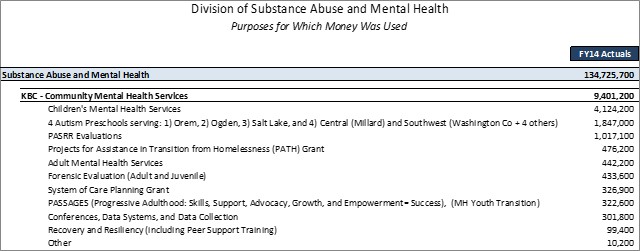
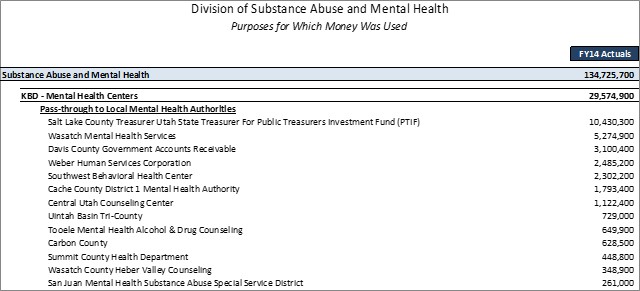
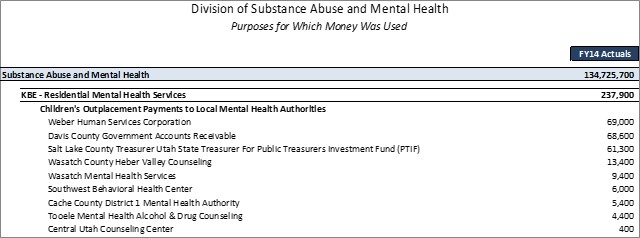


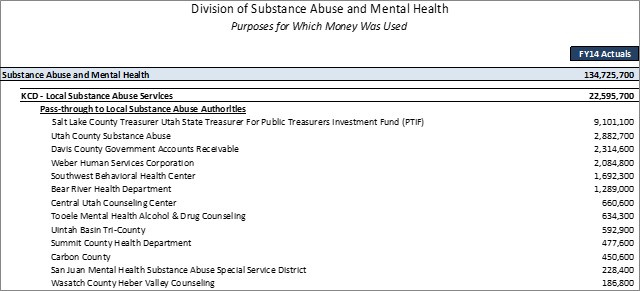
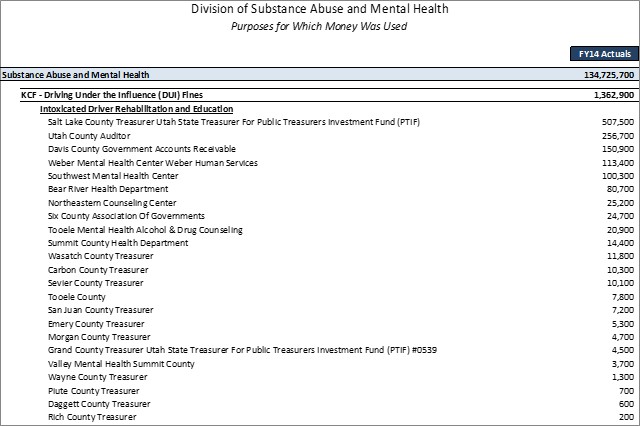
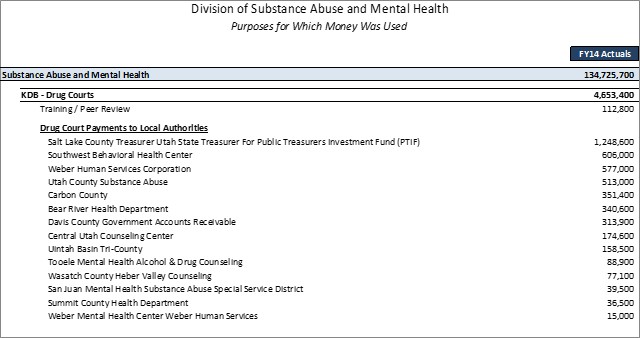
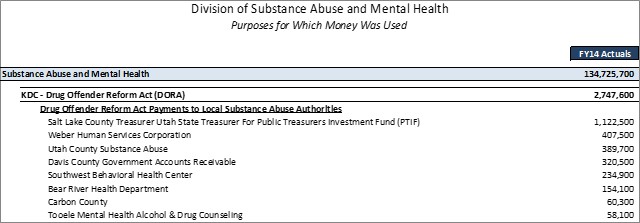
Mental Health Medicaid Match Intent Language Report
Local Mental Health Authority Medicaid Match Report
Performance measures can be found at the individual program level.
The Division of Substance Abuse and Mental Health includes information on its website showing performance of local mental health and substance abuse authorities. Additional outcome data can be found at:DSAMH Outcome data and local mental health and substance abuse authority reviews at:Local Authority / County Monitoring Reports
State statute assigns the responsibility to provide substance abuse and mental health services to the local authorities (counties). The local authorities provide services directly or contract with private providers (such as Davis Behavioral Health in Davis County). Counties may elect to perform their local authority responsibilities singularly or through an interlocal agreement between multiple counties. In Utah, counties are currently organized as thirteen (13) local mental health authorities and thirteen (13) local substance abuse authorities. Counties are required to provide at a minimum the services mandated by state statute and must provide matching funds equal to at least twenty percent (20%) of most state General Fund passed through to local authorities.
The Public Local Mental Health Authority System
The state public mental health system serves adults with serious mental illness and children with serious emotional disturbances. Many of the recipients do not have private insurance and have limited financial resources. Local authorities, through consultation with the DSAMH, have established schedules that base fees on income levels and family size.
Mental health services are funded by a variety of revenue streams including state General Fund revenue, county funds, Medicaid and Medicare, other third party payers, and client fees. Medicaid is the primary funding stream for mental health services provided by local authorities. In addition, the state applies for and receives a federal Mental Health Services Block Grant (MHBG). Funding from the MHBG supplements other sources of revenue for mental health services in the state.
Local mental health authorities review and evaluate the mental health needs and services of their local populations including those of incarcerated individuals. They prepare annual plans for mental health funding and service delivery for adults, youth, and children. These plans are submitted to and approved by the DSAMH and include the following services mandated by Utah Code:
- Inpatient care and services;
- Residential care and services;
- Outpatient care and services;
- 24-hour crisis care and services;
- Psychotropic medication management;
- Psychosocial rehabilitation, including vocational training and skills development;
- Case Management;
- Community supports, including in-home services, housing, family support services, and respite services;
- Consultation and education services, including case consultation, collaboration with other county service agencies, public education, and public information; and
- Services to incarcerated persons (UCA 17-43-301).
Local mental health centers also provide additional services including peer support, school-based services, mobile crisis outreach teams, crisis lines, housing, clubhouses, consumer drop-in centers, employment and rehabilitation, services to the homeless, family respite, nursing home and hospital alternatives, and consumer education.
The Public Local Substance Abuse Authority System
The state public substance abuse system serves any person in need of substance abuse services. Local authorities are required to charge a fee for substance abuse services rendered. However, no individual may be refused service because of an inability to pay. Local authorities through consultation with the DSAMH have established schedules that base fees on income levels and family size. Because of funding limitations, individuals may experience delays in the availability of services. Priorities for services include the following:
- Pregnant women;
- Intravenous (IV) Drug Users;
- Women with dependent children; and
- All others.
In addition to the priority populations listed above, significant public resources are focused on individuals in the criminal justice system (see also the separate section of this report on drug courts). Annually, the state applies for and receives a federal Substance Abuse Prevention and Treatment Block Grant. Funding from this grant supplements the General Fund appropriations for substance abuse services in the state. This federal grant requires that the state, through the local substance abuse authorities, provide a continuum of the following services:
- Detoxification;
- Prevention services;
- Outpatient services;
- Intensive outpatient services; and
- Residential treatment programs.
There are two restricted accounts that are used in connection with the Division of Substance Abuse and Mental Health: 1) Tobacco Settlement Restricted Account and 2) Intoxicated Driver Rehabilitation Account. A five year history of each account is shown here:
For analysis of current budget requests and discussion of issues related to this budget click here.
Special Funds
There are two restricted accounts that are used in connection with the Division of Substance Abuse and Mental Health: 1) Tobacco Settlement Restricted Account and 2) Intoxicated Driver Rehabilitation Account. A five year history of each account is shown here:
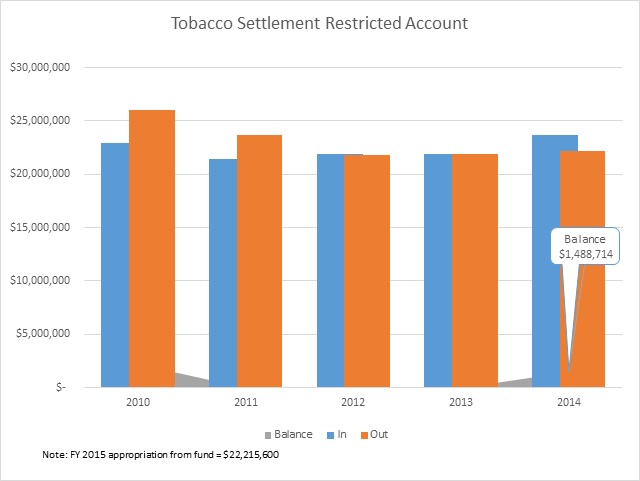
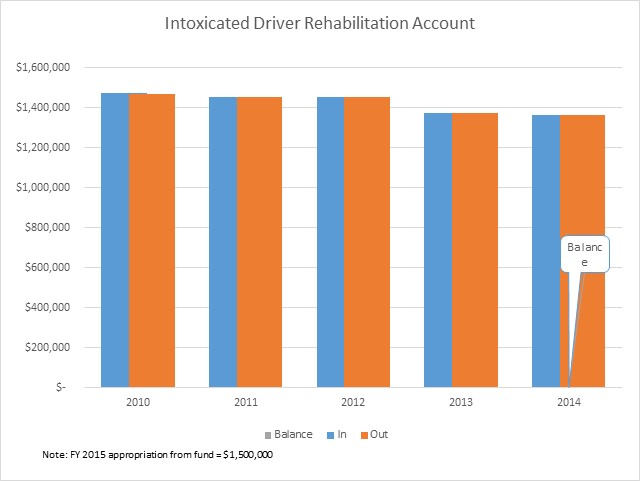
COBI contains unaudited data as presented to the Legislature by state agencies at the time of publication. For audited financial data see the State of Utah's Comprehensive Annual Financial Reports.